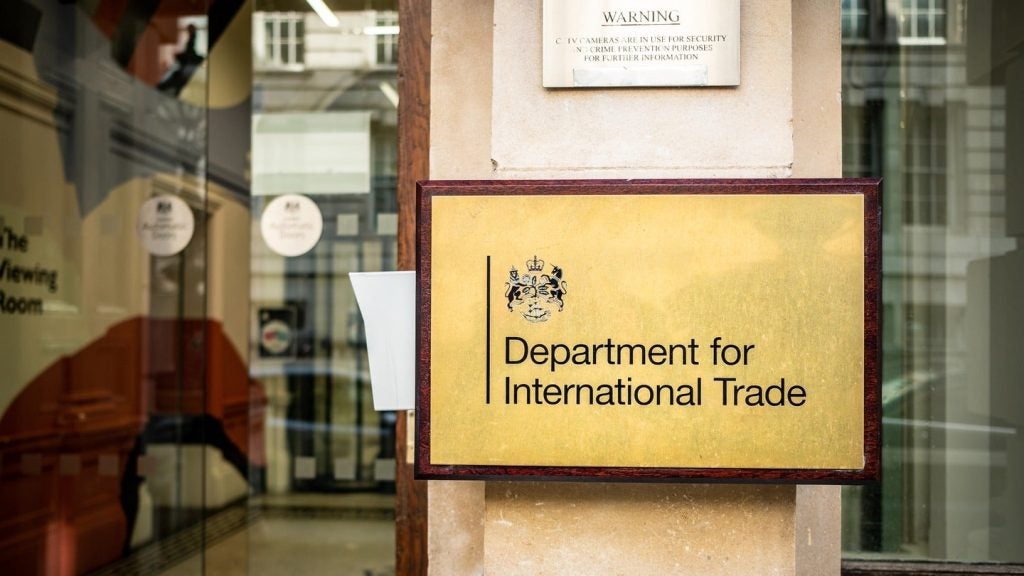
Trouble ahead for US commercial cards?
It may be the world’s largest market for commercial
cards but a number of factors are converging which could pose
significant challenges to the US corporate payments market.
Downward pressure on interchange fees and constrained credit
availability may mean current models need to be re-thought, writes
William Cain.
The US is the world’s largest market for commercial card
spending, but there remains a feeling that the industry has failed
to fulfil its potential so far.
How well do you really know your competitors?
Access the most comprehensive Company Profiles on the market, powered by GlobalData. Save hours of research. Gain competitive edge.

Thank you!
Your download email will arrive shortly
Not ready to buy yet? Download a free sample
We are confident about the unique quality of our Company Profiles. However, we want you to make the most beneficial decision for your business, so we offer a free sample that you can download by submitting the below form
By GlobalData This
This
is because, peculiarly, as markets around the world experience
declining cheque usage and are in some cases phasing them out,
cheques in the US remain a resilient and even preferred method of
payment for many businesses.
Around 65% of large and mid-sized
companies in the US pay their major suppliers by cheque, compared
to just 4% on purchasing cards. This is the result of the
development of a much improved cheque clearing system.
Up until the late 1990s, the cheque
clearing system required the Federal Reserve to maintain a fleet of
11 aeroplanes to transfer cheques between its clearing centres
across the country.
Now, cheques are truncated, sent
and processed electronically as a result of reforms to the system
in 2005. In addition, corporates in the US are continuing to use
them because of what has been described as a “schizophrenic”
strategy towards their payments systems.
In order to improve their working
capital balances in a credit-constrained environment, corporates
are promoting efficiency to speed up their accounts receivable
processes while at the same time using cheques to slow down
accounts payable.
With cheques popular and still
relatively efficient in the US, how do card issuers persuade
corporates to implement commercial card programmes?
One of the key strategies has been
through a system of rebate incentives offered to corporates on
their business-to-business payments. The rebate is paid out of
interchange fees charged to the recipients of card payments –
typically 2.2% of transaction spend volume in the US.
Card-spend
kickbacks
 While interchange is an important source of revenue for
While interchange is an important source of revenue for
card issuing banks they have in recent years become more willing to
share some of this revenue with clients in order to drive greater
spending volumes.
The value of the rebates can be
extremely large, depending on the size of the organisation and
their expected spending on commercial cards. A 2010 proposal put
together by US Bank for the State of West Virginia (SWV) gives an
insight into how these rebates are structured.
The first part of the calculation
is valued by using a US Bank matrix which takes into account the
organisation’s average transaction size and the volume of payments
in the commercial cards programme.
The rebate increases as volume and
average transaction size increase. The lowest rebate value is 1.03%
of total spending net of credit losses, which corresponds to an
average transaction size of $150 and a volume of 100m payments.
Qualifying for the highest rebate,
which is valued at 1.5%, requires 1bn transactions at an average
value of $700.
The second part of the calculation
is assessed by the number of days it takes the organisation to
repay US Bank for the credit it provides through the charge card
programme.
If SWV repays the bank immediately
for purchases made on the cards, it receives a bonus rebate of 0.4%
on top of the matrix-derived rebate described previously. This
bonus payment declines the longer payment is deferred, reaching
zero at 40 days.
 In the document, US Bank shows that a $335m net annual
In the document, US Bank shows that a $335m net annual
charge volume with a $500 average transaction size and a 29-day
‘file turn’ (credit period) would create a matrix-derived rebate of
1.4755% and a 29-day payment deferral bonus of 0.11%.
As a percentage of the $335m annual
spend, US Bank says signing up to the programme would deliver $5.3m
in rebates to SWV on an annual basis, which works out at $1.3m on a
quarterly basis or $26.6m over a five-year period.
The proposal says that efficiency
savings in SWV’s expense management systems may exceed the value of
the rebates it receives.
“US Bank is committed to providing
competitive financial incentives to the state,” the document
says.
“We recognise the auditor’s goal of
growing the programme. Therefore, we have structured an aggressive
rebate to demonstrate the rebate potential of your growing program.
If the state would like an upfront bonus, we can negotiate that out
of the existing rebate grid.
“The following financial proposal
details the volume and speed of payment incentives. The full
picture of the financial impact of US Bank commercial card
programmes is made up of three components: a competitive incentive
programme; proven strategies for increasing programme volume and
tools for cutting procurement costs.
“The savings that can be accrued to
the state is significant, often far surpassing the rebate dollars
that an organisation earns.”
Rebate
realities
 Research from consultancy First Annapolis suggests that a
Research from consultancy First Annapolis suggests that a
rebate value of 1.4755% is rare and that they are typically paid at
around a quarter of the 2.2% average interchange rate – or 55 basis
points, because spending tends to be much lower.
Its research, Commercial Card
Rebates – A Snapshot from the Public Sector, shows that
typically rebates do not start until annual card volume reaches $1m
and that rebates vary substantially across different clients and
issuing banks.
Michigan state was offered a rebate
of under 10 basis points for annual spending of more than $10m per
year, compared to Minnesota, which was offered around 85 basis
points.
This, according to First Annapolis,
highlights that rebates should not be the only consideration when
considering a commercial card programme.
“We strongly believe that, while
rebates should not be ignored, the supplier savings and process
improvements opportunity for an organisation from implementing or
re-launching a commercial card programme are worth multiples of any
rebates that may be generated,” the report says.
The rebate model has been pursued
more aggressively in recent years, according to Gareth Lodge, a
payments analyst at consultancy Celent, as banks try to increase
their corporate card volumes.
Lodge says the value of rebate
offers have increased four-fold in the past 10 years in an attempt
to incentivise corporates to use card products more
intensively.
 However, the business model may come under threat in coming
However, the business model may come under threat in coming
years as regulatory and economic pressures grow. The core elements
of profitability from commercial card offerings are interchange and
the cost of funds.
Banks offering the products are
able to source short term credit at relatively cheap rates in the
current environment, with US interest rates at their lowest point
in history.
This means the cost of funding
credit to corporates on their charge card products is extremely low
and has perhaps contributed to the leeway some have been willing to
offer on rebates.
Lodge questions how long these two
fundamental parts of the commercial cards landscape will stay in
place.
“One of the reasons corporate cards
and prepaid cards at the moment are so popular and remain a growth
market is because they haven’t come under the interchange
scrutiny,” says Lodge.
“Banks are still making money on
those products as opposed to debit cards which have become a lot
less profitable. The profit margin on commercial cards has fallen
as more and more people go for the rebate model to drive
volume.
“Overall profit is growing but
profit margins are falling. If the regulator then intervenes either
by raising interest rates – and the cost of funds goes up – and/or
they reduce interchange, then that business models around
purchasing cards becomes potentially far less attractive.”
 Interchange scrutiny in the US is growing after the
Interchange scrutiny in the US is growing after the
decision by regulators to reduce the fees charged for debit card
transactions.
Lodge says the US move, through the
Durbin Amendment to the Dodd-Frank Wall Street Reform bill, marks
another big step in the push for more transparent pricing of
payments products, which is already underway in Europe and
Australia.
Of particular relevance to this is
a recent decision taken in Europe to phase out and potentially ban
the charging of interchange fees on all SEPA and domestic direct
debits.
Lodge says this could pave the way
for a similar investigation in the US, potentially placing further
downward pressure on interchange fees and, ultimately, the revenues
earned by banks on card products.
“It raises the interesting question
– why are they treating one payment type different to another?” he
says.
“There are a number of people
asking, given that there is a new focus on transparency, about why
this is allowed to happen in some cases and not in others – why are
some very transparent and not others.
“In France, for example, there is a
legal obligation to offer cheques for free. That would seem to
potentially breach European law. That’s what is happening in
Europe.
 “If
“If
you look at what is happening around the world, there’s a big move
in Australia for the growth in transparency of payments. If you
look at the US, we have just seen the first wave of transparency
and intervention on interchange for debit cards.
“So, while I am not saying it
[further downward pressure on interchange] will happen, there’s a
growing possibility that there will be some kind of investigation
or study into the transparency of products in the US as well.”
This would imply a rethinking of
commercial card strategies by issuing banks, requiring a reduction
of rebate payment incentives to corporates.
Longer term, it could mean banks
would be forced to charge corporates for the products in the same
way some are now doing for debit cards.
This may actually lead to more of a
focus on the real value-added element of the programmes – to
improve efficiency and reduce costs – rather than the level of
rebates corporates will earn.
“When you are looking for a
corporate programme, how do you choose between one provider and
another?” asks Lodge.
“It is going to be around value-add
– how well can I integrate it into my accounts payable programme,
what formats does it use and how can I upload it into an expenses
system etc, so the integration and automation is there.”
As in other Electronic Payments
International surveys, the savings and efficiencies generated
by greater automation of payments process have become more
important in the US since the recession.
Cheques still
central
Improving payments systems is one
of a number of options considered by corporate treasury departments
in order to maximise the working capital they hold.
 The
The
biggest focus among chief financial officers of US companies
revolve around a number of key areas, according to a February 2011
survey conducted by RBS Global Banking and Markets in North
America.
These are:
- improving of process
efficiency; - negotiation of better terms
with suppliers and buyers; - improvement of internal
information systems through the acquisition of new technology and
better integration of existing systems; and, - provide better sales and
collections support operations.
Yet, improving payments efficiency
is a double edged sword for corporates. If systems are improved to
allow faster access to receivables it should also mean payables are
settled more quickly too. The net effect on working capital in this
case is zero.
Corporates, then, have an incentive
only to improve efficiencies on the accounts receivables side of
their business, rather than accounts payable – a trend Lodge
already sees in action.
“The credit crisis has almost had a
schizophrenic impact on corporate strategies,” says Lodge.
“On one hand, you want to push all
of your payers for prompt payment. So you want to receive it
electronically because you want to be able to process it quicker
and it’s easier to reconcile.
“You also know what you can draw on
in your bank account much more quickly so you don’t have to borrow.
That kind of liquidity management is important.
“Equally, you want to pay people as
slowly as possible. The old saying that the cheque’s in the post –
it helps slow that process going out.”
This is one part of the reason
cheques remain an integral part of commercial payments in the US,
while they remain much less so in the consumer sphere in the US.
Another reason is that, following the introduction of the Check
Clearing for the 21st Century Act (Check 21), the clearing system
for cheque payments has been significantly improved.
The act legalised ‘substitute
cheques’ that allowed physical cheques to be sent in electronic
form and reproduced from an electronic image if necessary to
complete the transaction process.
This allows banks to accelerate
collection and reduce paper handling and paper handling costs,
according to the Federal Reserve Bank of Kansas City and is
particularly popular among smaller banks. It has also allowed the
consolidation of clearing centres.
This system is a far cry from the
days when the Federal Reserve, which conducts cheque clearing in
the US, maintained a fleet of 11 aircraft to transport cheques from
one clearing centre to another. It has created an efficient system
for cheques which has made migration to alternatives less appealing
to consumers and corporates.
“To describe the cheque clearing
system as a transformation is probably stretching it a bit too
far,” says Lodge.
“But there have been some big
improvements in the process and that is one of the other reasons
why perhaps the change is not going to go as quickly in some other
countries.
“It has made sufficient
improvements to make the final leg of migration to other payment
formats less palatable, or created less of a driver for it.”
The barriers to migrating cheque
payments commercial cards is a theme picked up by the Payment Cards
Center of the Federal Reserve Bank of Philadelphia (FRBP).
Its March 2011 report into
commercial payments in the US, Getting Down to Business:
Commercial Cards in Business-to-Business Payments, says cards
have not achieved the same level of adoption as in the consumer
environment for a number of reasons.
First, commercial cards have not
been a feature of the US commercial market for as long as card
products have among consumers.
Secondly, there is the issue of
acceptance. Much like the development of consumer card payments,
commercial card usage needs to be supported by an acceptance
infrastructure.
For travel and entertainment
spending, acceptance is not an issue because the types of vendors –
restaurants, bars, airlines and hotels – were among the first to
accept card payments for consumer payments, the FRBP research
says.

Procurement
cards
In the area of procurement cards (P-cards), creating a wide
acceptance infrastructure is more challenging.
The types of organisations which
goods and services are procured from by corporates tend not to be
consumer-facing and have never had a need to be able to accept card
payments.
Research conducted by the
Association for Financial Professionals (AFP) in the US looked at
the reasons why these business-to-business (B2B) vendors are
reluctant to accept card payments.
Among those who did not accept card
payments, 18% said the fees associated with interchange were a key
reason for not doing so.
Among those who did offer card
payment facilities, 68% identified interchange fees as the primary
disadvantage of accepting the payments. Around 88% said the main
reason they offered card acceptance was because it satisfied their
customers’ payments preferences.
The AFP research highlighted other
benefits to businesses which accept cards for B2B payments.
They include the faster receipt of
payments, decreased number of days of payments outstanding and the
elimination of collections activity.
“Over time, some providers to
commercial customers may arrive at the same conclusion that many
retailers reached several decades ago,” says the report, written by
the FRBP’s Susan Herbst-Murphy.
“The cost of card acceptance can be
less than managing accounts receivable internally, including the
costs of underwriting, billing, receivables, processing and
collections.”
The report’s overall conclusion is
that commercial payments in the US have yet to enjoy the widespread
usage that consumer cards have achieved but remains a market of
great potential.
The overall value of transactions
made by corporates in the US is three times larger than in the
consumer market. Each 1% that migrates to card payments represents
$200bn in gross dollar volume to card issuers.
As the value proposition is refined there are possibilities for
further growth, particularly as the benefits from value-added
services, like management reporting and regulatory compliance
functions, become more widely understood by corporates. But the
preference for cheques in the US is proving hard to break.






